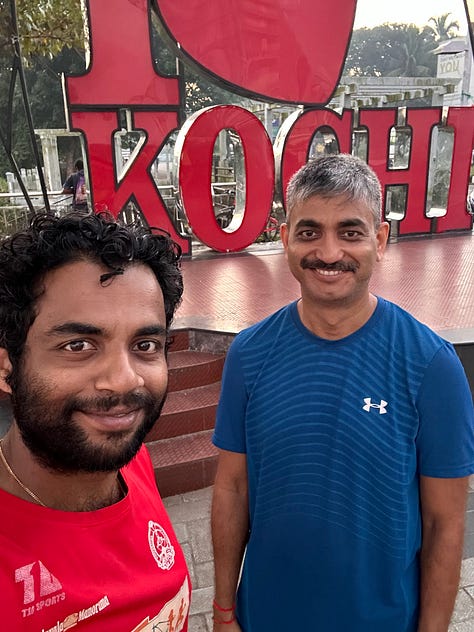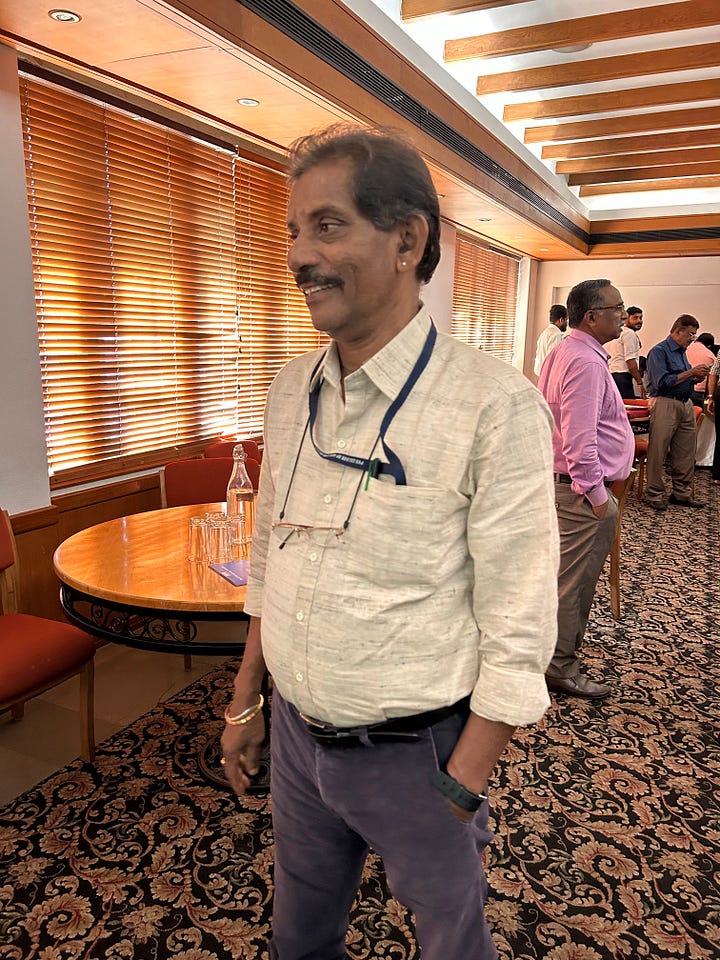Contested Boundaries
Survival of the Default
I firmly believe that the responsibility for sustainability rests significantly on teachers at multiple levels of education system. They play a pivotal role in shaping future leaders and innovators who can address global challenges. Academics are responsible for integrating sustainability into curricula, conducting research for solutions, and instilling a sense of environmental and social responsibility in students, thus fostering a sustainable mindset.
If you are reading for the first time, please subscribe for a weekly email discussing Running Platform Marketing Life.
AND if you are a friend of the RPML, do share it with others. You can add more of your friends to the Community of Platform’ed by using the following link.
Do share your feedback on this newsletter if you have not done it yet.
DTW
During the Week, I closely followed testimonies from the ongoing landmark US v. Google antitrust trial. I could sympathise with Microsoft CEO Satya Nadella statement that unfair tactics used by Google led to its dominance as a search engine, tactics that in turn have thwarted Bing, (affectionately also called But It Is Not Google). Contrast this with Apple’s Eddy Cue comment: “One of the benefits that Google gets from Apple is that we’re telling the world Google is the best search engine, because that’s what customers expect us to pick.” and you would understand the helplessness of Satya Nadella against the combination of Apple’s distribution and Google Search product.
I have multiple times emphasised the overwhelming power of distribution over product or simply average product supported by great distribution triumphing over anything else. (Distribution Triumphs Product)
In the ever-evolving landscape of tech giants vying for global supremacy, four formidable pillars emerge as the cornerstones of dominance in the digital realm. These pillars captured in the acronym "MOAT," represent the strategic moats that tech giants like Apple, Amazon, Facebook, Google, and Microsoft employ in their quest to assert control over the world's digital infrastructure.
1. Marketplace Dominance (M): The first pillar, Marketplace Dominance, lies at the heart of this contest. Amazon, with its relentless focus on e-commerce, has built an unrivaled marketplace model. It thrives on the network effects generated by connecting buyers and sellers, creating a self-reinforcing cycle of growth. This dominance extends not only to online retail but also to cloud computing, entertainment, and more. Amazon's marketplace is a prime example of how control over transactions and commerce can be a monumental moat. Microsoft, with its Azure cloud platform and enterprise solutions, presents a formidable challenge to Amazon's dominance, particularly in the realm of business services and cloud infrastructure.
Apple has achieved an extremely high degree of market dominance in several product categories, such as smartphones, tablets, and computers. Their products are known for their quality, design, and performance, and their loyal customer base has helped them maintain a strong market position. Their dominance is reinforced by their ability to create a closed ecosystem, where their products are tightly integrated and work seamlessly together.
2. Online Platform Control (O): The second pillar, Online Platform Control, signifies the pivotal role of platforms in this battle. Facebook, with its suite of social media platforms like Facebook, Instagram, and WhatsApp, exerts unparalleled influence over online communication and social interaction. These platforms are interconnected, reinforcing user engagement and making it challenging for competitors to disrupt the ecosystem. Facebook's dominion in the realm of social platforms demonstrates the power of controlling the digital spaces where users congregate. Microsoft's ownership of LinkedIn adds another layer to this competition, as it holds a prominent position in the professional networking sphere.
Amazon's platform control is perhaps the strongest of all the tech giants. They have become a dominant force in e-commerce, providing a platform for millions of merchants and customers to connect and transact. They also have a strong presence in cloud computing, media streaming, and AI-powered home assistants. Their dominance stems from their ability to leverage their massive scale and data to offer a better experience for both sellers and buyers, and they continue to expand their presence into new categories and markets.
3. Access to Data (A): The third pillar, Access to Data, underscores the significance of data as a strategic asset. Google, renowned for its search engine dominance, leverages this position to accumulate vast amounts of user data. This data, in turn, fuels its advertising business and provides insights that drive innovation across various sectors. Google's ability to harness data not only fortifies its advertising moat but also enables expansion into fields like artificial intelligence and cloud computing. Microsoft, with its extensive enterprise software offerings, possesses a wealth of data related to businesses, further intensifying the competition in data-driven domains.
Facebook has been a dominant player in social media and online advertising for over a decade, and their strength lies in their access to data. They have a wealth of information on their users' demographics, interests, and behavior, which they use to target ads and content. They also use this data to improve their platform and make it more engaging for users. The question that is often raised is whether Facebook is doing a good job of protecting this data, which is a complex and controversial topic.
4. Territorial Expansion (T): The final pillar, Territorial Expansion, represents the audacious moves these tech giants make to broaden their influence. Amazon's aggressive diversification beyond e-commerce into cloud services, entertainment, and physical retail exemplifies territorial expansion. Facebook's acquisition of WhatsApp and Instagram demonstrates its commitment to expanding its reach and influence. Apple's global footprint, coupled with its foray into services, showcases its territorial ambitions. Microsoft, with its global enterprise presence and Azure cloud platform, extends its territorial control deep into the business and cloud computing domains.
Google has long been a dominant player in search and online advertising, and they have expanded their reach into a wide range of other industries, such as hardware, cloud computing, and even self-driving cars. They have achieved this expansion by leveraging their core strength in data and AI, and by aggressively acquiring other companies that can help them expand their territory. Their dominance has raised some concerns about their size and power, and they have been the subject of antitrust investigations in several countries.
I would discuss the response of Indian Digital and otherwise businesses in next edition in detail but I think there are a few ways that Indian conglomerates are responding to the battle for dominance in the digital space. Firstly, they are investing heavily in their own digital infrastructure, such as data centers and cloud computing. Secondly, they are partnering with global tech giants to bring their services and products to the Indian market. And finally, they are investing in their own homegrown tech startups, to create their own digital products and services.
As the battle for global digital supremacy unfolds, these four pillars, Marketplace Dominance, Online Platform Control, Access to Data, and Territorial Expansion, serve as a compass guiding the strategies of Apple, Amazon, Facebook, Google, and Microsoft. It's a contest not merely of technological prowess but also of constructing the most robust strategic moats, fortifying their dominion, and shaping the future of the digital world. Each of these tech giants brings its unique strengths and ambitions to the table, creating a dynamic and competitive landscape that will continue to redefine the digital infrastructure of our world.
OTW
Over the Weekend, I was in Kochi as a resource person for Regional Principals’ Meet on Sustainability. It was an enriching experience to hear the academic leadership in Kerala discuss the sustainability best practices in teaching, research and community engagement. Their commitment to sustainability bodes well for the forward march towards sustainable future for all.
Being in Kochi also provided me with a much awaited visit to Ayni Farmstay (near Munnar) curated by Neha Bhalla. Neha, the founder of Ayni Farmstay, has embarked on an incredible adventure from being a solo female travel photographer to building her dream project in the serene landscapes of Kerala. This journey of Ayni Farmstay started with a thought to create a space where people can relax, rejuvenate and get in touch with their creative self. Nature plays an important role in this process and that's the locus of this initiative.
You may want to follow her Instagram page @itchhyfeet to stay updated on her inspiring journey and photography. Also, follow Ayni Farmstay's Instagram page @ayni_farm to explore the beauty of this nature-centric retreat. Neha's passion for blending nature, creativity, and travel is an inspiration to us all. It is time for us to come together as a community to celebrate her achievements and support her in this beautiful endeavor.
Talking of entrepreneurship, Vishal Ravi MBA2018 IBS Hyderabad is also following his passion in sports to craft amazing products and services for larger sports and fitness community through his enterprise explayersindia.








This has been a busy weekend as I connected with many friends over a short period of time and was simultaneously able to spend quality time with all of them.
I Love You
Shailendra




